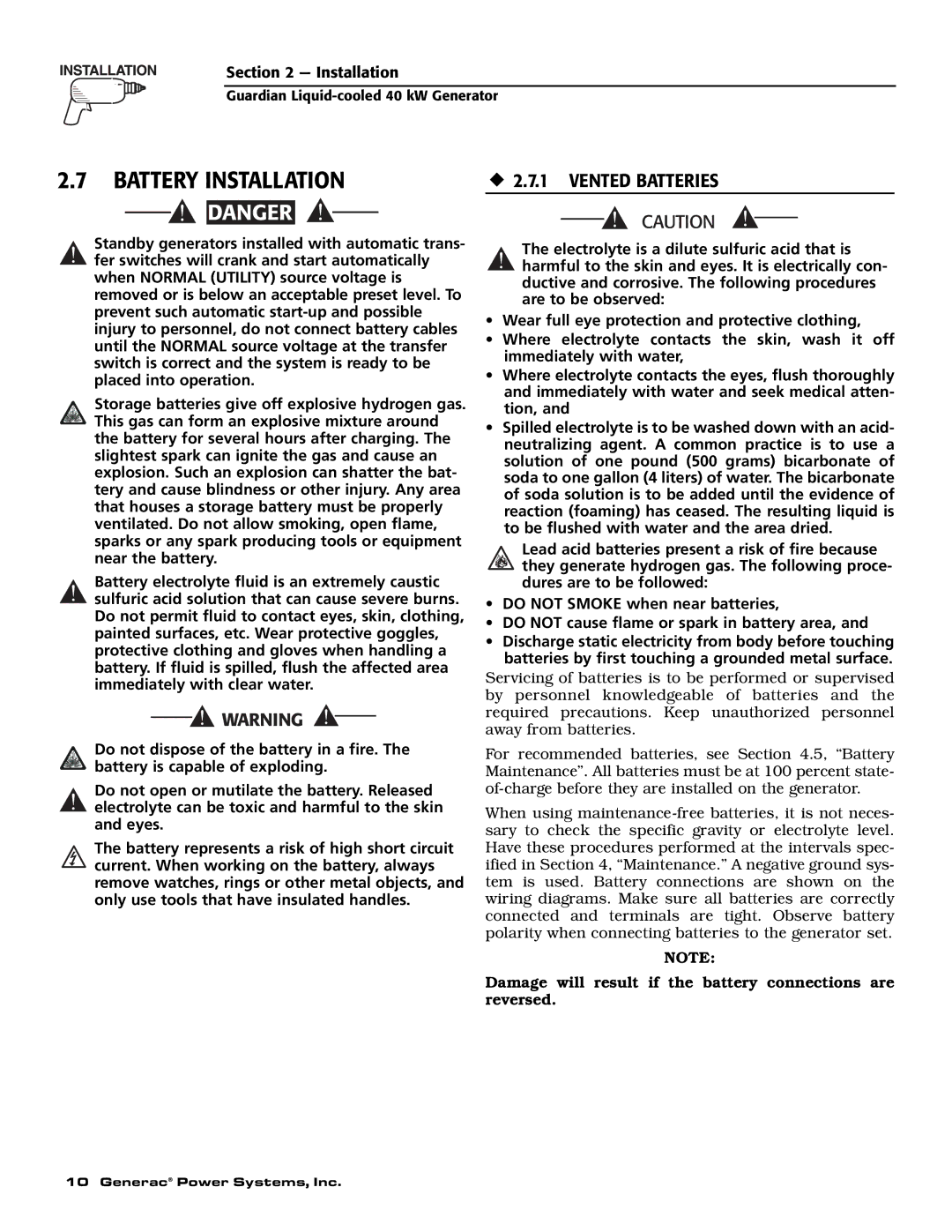
Section 2 — Installation
Guardian
2.7BATTERY INSTALLATION
![]()
![]() DANGER
DANGER
Standby generators installed with automatic trans- ! fer switches will crank and start automatically
when NORMAL (UTILITY) source voltage is removed or is below an acceptable preset level. To prevent such automatic
Storage batteries give off explosive hydrogen gas. This gas can form an explosive mixture around the battery for several hours after charging. The slightest spark can ignite the gas and cause an explosion. Such an explosion can shatter the bat- tery and cause blindness or other injury. Any area that houses a storage battery must be properly ventilated. Do not allow smoking, open flame, sparks or any spark producing tools or equipment near the battery.
Battery electrolyte fluid is an extremely caustic ! sulfuric acid solution that can cause severe burns.
Do not permit fluid to contact eyes, skin, clothing, painted surfaces, etc. Wear protective goggles, protective clothing and gloves when handling a battery. If fluid is spilled, flush the affected area immediately with clear water.
Do not dispose of the battery in a fire. The battery is capable of exploding.
Do not open or mutilate the battery. Released ! electrolyte can be toxic and harmful to the skin
and eyes.
The battery represents a risk of high short circuit current. When working on the battery, always remove watches, rings or other metal objects, and only use tools that have insulated handles.
2.7.1 VENTED BATTERIES
The electrolyte is a dilute sulfuric acid that is
!harmful to the skin and eyes. It is electrically con- ductive and corrosive. The following procedures are to be observed:
•Wear full eye protection and protective clothing,
•Where electrolyte contacts the skin, wash it off immediately with water,
•Where electrolyte contacts the eyes, flush thoroughly and immediately with water and seek medical atten- tion, and
•Spilled electrolyte is to be washed down with an acid- neutralizing agent. A common practice is to use a solution of one pound (500 grams) bicarbonate of soda to one gallon (4 liters) of water. The bicarbonate of soda solution is to be added until the evidence of reaction (foaming) has ceased. The resulting liquid is to be flushed with water and the area dried.
Lead acid batteries present a risk of fire because they generate hydrogen gas. The following proce- dures are to be followed:
•DO NOT SMOKE when near batteries,
•DO NOT cause flame or spark in battery area, and
•Discharge static electricity from body before touching batteries by first touching a grounded metal surface.
Servicing of batteries is to be performed or supervised by personnel knowledgeable of batteries and the required precautions. Keep unauthorized personnel away from batteries.
For recommended batteries, see Section 4.5, “Battery Maintenance”. All batteries must be at 100 percent state-
When using
NOTE:
Damage will result if the battery connections are reversed.
10 Generac® Power Systems, Inc.
